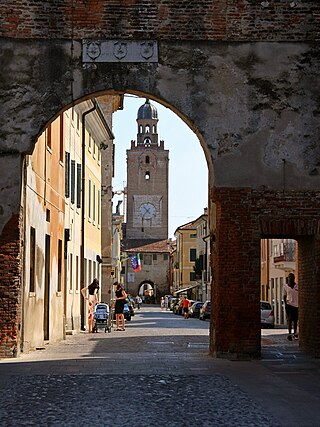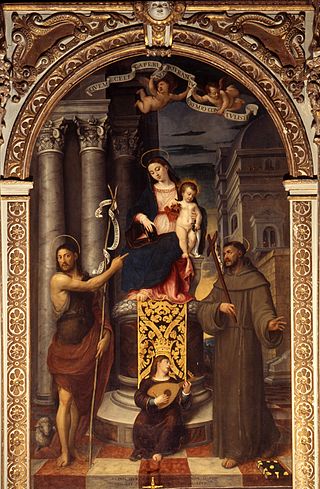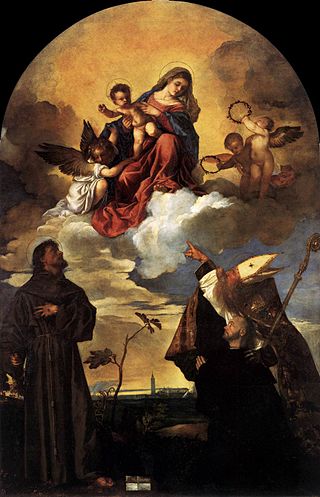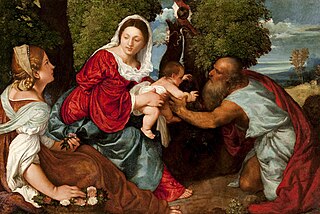
Tiziano Vecellio, Latinized as Titianus, hence known in English as Titian, was an Italian Renaissance painter, the most important artist of Renaissance Venetian painting. He was born in Pieve di Cadore, near Belluno. During his lifetime he was often called da Cadore, 'from Cadore', taken from his native region.

Castelfranco Veneto is a town and comune (municipality) of Veneto, northern Italy, in the province of Treviso. It is the third largest municipality in the province by population after the capital Treviso and Conegliano. It is centrally located between the cities of Treviso, Padua and Vicenza, it is a walled city with a well-preserved medieval castle.

Francesco Beccaruzzi was an Italian painter of the Renaissance era, active near his hometown of Conegliano and in the neighborhood of Treviso. He was influenced by both Il Pordenone and later Titian. He painted Saint Francis receiving stigmata (1545) from Conegliano, but now in the Gallerie dell'Accademia in Venice.

Francesco Vecellio was a Venetian painter of the Italian Renaissance. He was the elder brother and close collaborator of the painter Tiziano Vecellio ("Titian").

The da Camino were an Italian noble family whose fame is connected to the mediaeval history of the March of Treviso, a city of which they were lords for a while.

La Schiavona, also known as Portrait of a Lady, is a 1510–1512 portrait by Titian of an unknown woman.

The Gozzi Altarpiece is an oil painting by the Italian Renaissance master Titian, dating from 1520. It is located in the Pinacoteca civica Francesco Podesti, in Ancona.

The Portrait of Charles V is an oil on canvas portrait of Charles V, Holy Roman Emperor by Titian, painted in 1548. As with the Equestrian Portrait of Charles V, it was commissioned by Charles during Titian's stay at the imperial court at Augsburg. It is now in the Alte Pinakothek in Munich, Germany.

The Portrait of Isabella of Portugal is an oil-on-canvas portrait of Isabella of Portugal, Holy Roman Empress by Titian dating to 1548. It was part of the Spanish royal collection and is now in the Museo del Prado, in Madrid.

Portrait of Lavinia Vecellio is an oil on wood portrait by Titian, from c. 1545. It is believed to depict his daughter Lavinia. It is held in the Museo di Capodimonte, in Naples.

The Madonna of the Cherries is a 1515 painting by Titian, heavily influenced by the work of Giovanni Bellini. Originally oil on wood, it was later transferred to canvas. During the 17th century it formed part of the collection of Archduke Leopold Wilhelm, where it was copied by David Teniers. It is now in the Kunsthistorisches Museum, in Vienna.
Francesco da Milano was an Italian painter from Lombardy. He was active between 1502 and 1548 and twenty of his works in oil-on-canvas and fresco survive in the hill-country of Treviso and Friuli, including a fresco cycle at Castello Roganzuolo. As a Lombard, some aspects of his style were influenced by Bernardo Zenale and Vincenzo Civerchio, though he was also influenced by Titian, who like him lived and worked in the "contrada de Piai" in Serravalle. Titian was preferred to Francesco by Serravalle's town council - Francesco had been the initial choice to paint the Serravalle Altarpiece.

The Serravalle Altarpiece or Madonna and Child in Glory with Saint Andrew and Saint Peter is an oil on wood painting by Titian, from c. 1542-1553. It is, in the church of Santa Maria Nova in Serravalle, for which it was commissioned.
Col di Manza is a hill between the towns of Colle Umberto and San Fior in the province of Treviso in Italy, facing the higher hill of Castello Roganzuolo. It is notable as the site of a villa built for the painter Titian.

The church of San Giorgio alla Costa, called in earlier times also dei Santi Giorgio e Massimiliano dello Spirito Santo is a small historical church in the Oltrarno district of the centre of Florence, situated on the steep slope of via Costa San Giorgio which runs uphill from Ponte Vecchio to Forte di Belvedere.

The Scuola del Santo or Scoletta was the headquarters of the Archconfraternity of St Anthony of Padua. It overhangs the churchyard of Basilica of Saint Anthony of Padua, next door to the St. George's Oratory.

The Lochis Madonna is an oil on panel painting attributed to Titian and dated to around 1508–1510. It is now in the Accademia Carrara, in Bergamo. It is first recorded as part of the Lochis collection, after which it is named.

Madonna and Child with Saint Jerome and Saint Dorothy is a 1516 oil on canvas painting, now in the Kelvingrove Art Gallery and Museum in Glasgow, which purchased it from the McLellan collection in 1856. The Madonna's pose is based on that of Raphael's Esterhazy Madonna.

Virgin and Child with Saints Anthony Abbot, Jerome and Francis, also known as Madonna and Child with Three Saints or Adoration of the Christ Child with Saints, is an oil on canvas painting by Titian, from c. 1519. It is held in the Alte Pinakothek, in Munich.

Col Visentin is a mountain in the Bellunes Alps, in the Veneto region of Italy, which marks a geographical border point between the province of Belluno and the province of Treviso.


















